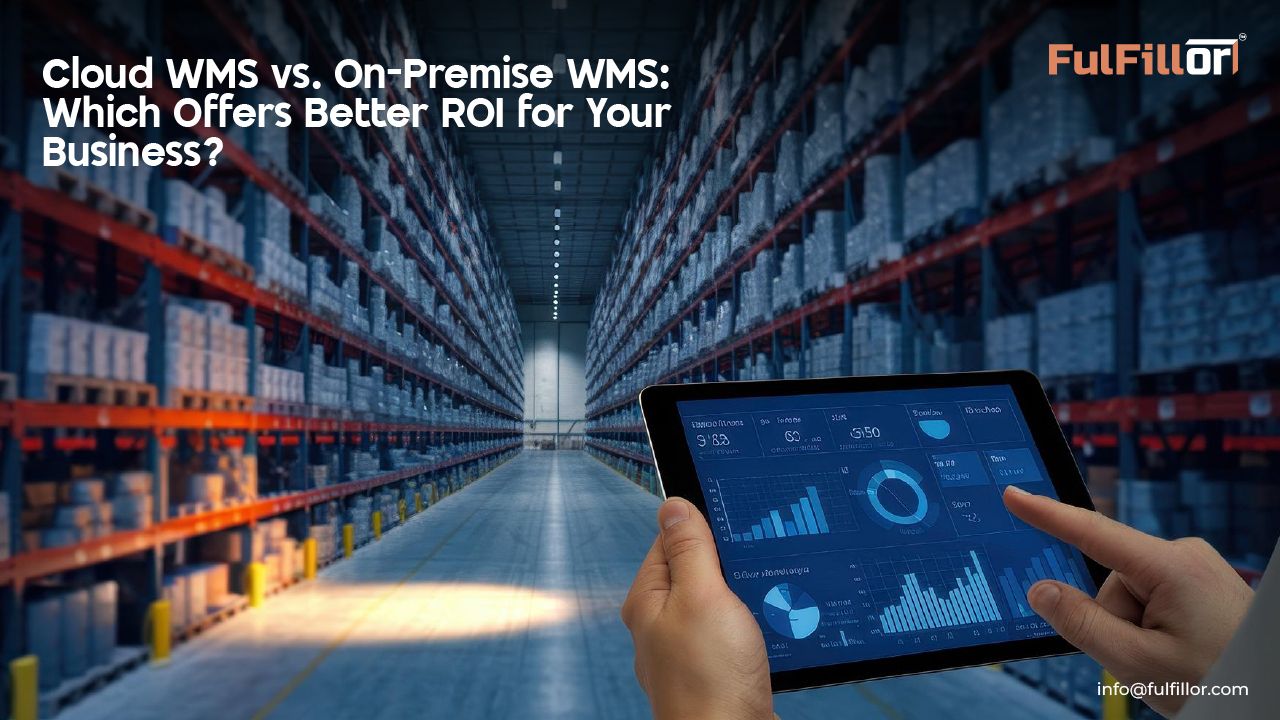Cloud WMS vs. On-Premise WMS: Which Offers Better ROI for Your Business?
Choosing the right Cloud-Based Warehouse Management System (WMS) is crucial for staying competitive in the logistics and inventory management industries.
Warehouse management systems have evolved significantly, offering businesses advanced tools to manage their inventory efficiently, whether through cloud-based solutions or traditional on-premise software.
A significant portion of enterprises was expected to rely on a hybrid cloud, integrating both on-premise resources and public clouds to optimize performance and security.
In this article, we’ll take a comprehensive comparison between cloud WMS and on-premise WMS, outlining the advantages of each to help business owners make an informed decision tailored to their specific needs.
Cloud WMS: A Complete Guide to Warehouse Management in the Cloud
What Is a Cloud-Based WMS and How Does It Work?
Cloud-based Warehouse Management System (WMS) operates over the internet, is hosted on vendor’s servers, and is accessible via web browsers. This model eliminates the need for businesses to maintain physical servers for their warehouse management.
Key Features:
-
Real-time Data Access: Users can access real-time information from any device connected to the internet, improving decision-making and operational responsiveness.
-
Scalability: Cloud WMS can easily scale with your business growth, allowing for additional storage or features without significant infrastructure changes. Integration Capabilities: These systems are designed to integrate seamlessly with other business tools, such as ERP systems and e-commerce platforms, creating a cohesive environment.
On-Premise WMS: An Overview of Traditional Warehouse Management Systems
What Is an On-Premise WMS? Benefits and Use Cases
On-premise WMS is installed locally on your company’s hardware and managed by your IT team. This setup provides full control over the WMS and its integration with other internal systems.
Key Features:
-
Control: Businesses have complete control over their WMS, including how it’s configured and when updates are applied.
-
Data Security: Keeping data on-premises can be more comforting for businesses with highly sensitive information.
-
Customization: On-premise solutions offer more room for customization compared to cloud solutions.
Cost Comparison: Cloud-Based vs On-Premise WMS
1. Subscription Fees
Cloud-based WMS platforms typically operate on a subscription model with recurring monthly or annual fees. These costs usually include software access, regular updates, and ongoing technical support.
Subscription pricing often scales based on factors such as the number of users, warehouse locations, order volume, and enabled features, allowing businesses to adjust costs as operations grow.
2. Implementation Costs
Cloud-based WMS solutions generally involve lower upfront implementation costs since there is no requirement to purchase or maintain on-site hardware. Initial expenses typically include system configuration, data migration, and customization to align the software with specific business workflows.
Additional costs may arise from training warehouse staff and administrators to use the system effectively, ensuring smooth adoption and minimal disruption to daily operations.
3. Maintenance and Support
For cloud-based WMS solutions, regular software updates, system maintenance, and technical support are typically included in the subscription fee. This reduces the need for in-house IT resources and helps keep the system up to date without additional costs.
System uptime and infrastructure management are handled by the service provider, which generally results in less downtime and lower operational risk compared to on-premise systems.
4. Hardware Costs
- Minimal: No need for significant hardware investments as the system is hosted on the provider's servers.
5. Security and Compliance
- Managed by Provider: The cloud provider manages the security measures and compliance with regulations, potentially reducing costs associated with these areas.
On-Premise WMS: Features, Benefits, and Use Cases
1. Licensing Fees
-
One-Time Cost: Requires a substantial upfront investment in purchasing the software license.
-
Upgrades: Additional costs for future software upgrades.
2. Implementation Costs
-
Higher Initial Costs: Includes costs for server hardware, network infrastructure, and other necessary IT equipment.
-
Customization: Potentially higher costs for customizing the software to fit specific business processes.
3. Maintenance and Support
-
Internal IT Team: Requires an in-house IT team to manage updates, maintenance, and support, leading to ongoing staffing costs.
-
Downtime: Responsibility for managing and mitigating downtime falls on the internal team.
4. Hardware Costs
- Significant Investment: Includes purchasing and maintaining servers, storage, and networking equipment.
5. Security and Compliance
- Internal Management: All security measures and compliance with regulations must be managed internally, potentially increasing costs for specialized staff and resources.
Comparative Analysis: Cloud-Based vs. On-Premise WMS
Initial Investment:
-
Cloud-Based: Lower initial investment due to minimal hardware requirements and subscription-based pricing.
-
On-Premise: Higher initial investment due to software licensing and hardware purchases.
Ongoing Costs:
-
Cloud-Based: Predictable, recurring costs that include maintenance and support.
-
On-Premise: Variable ongoing costs for maintenance, support, and potential hardware upgrades.
Scalability:
-
Cloud-Based: Easily scalable with adjustable subscription plans.
-
On-Premise: Scaling requires additional hardware and potential software upgrades, leading to higher costs.
Maintenance and Support:
-
Cloud-Based: Managed by the provider, reducing the need for a large in-house IT team.
-
On-Premise: Requires a dedicated IT team for ongoing support and maintenance.
Security and Compliance:
-
Cloud-Based: Managed by the provider, potentially reducing internal costs.
-
On-Premise: Internal responsibility, potentially increasing costs for specialized security and compliance measures.
Conclusion: Choosing the Right WMS for Your Business Success
Choosing between a cloud-based and an on-premise WMS depends on multiple factors, including cost, security, scalability, and the specific needs of your business.
While cloud WMS offers flexibility and lower upfront costs, on-premise solutions provide control and potentially better integration with existing infrastructure. Business owners should consider their operational needs, growth plans, and budget when deciding on the right Warehouse Management System to drive their business forward.
Consulting with a Warehouse Management System (WMS) expert can also provide tailored insights to make the best choice for optimizing your online operations. Meanwhile, those interested in continuing their education should look into this Research. com construction management degree online options relevant to the field.

